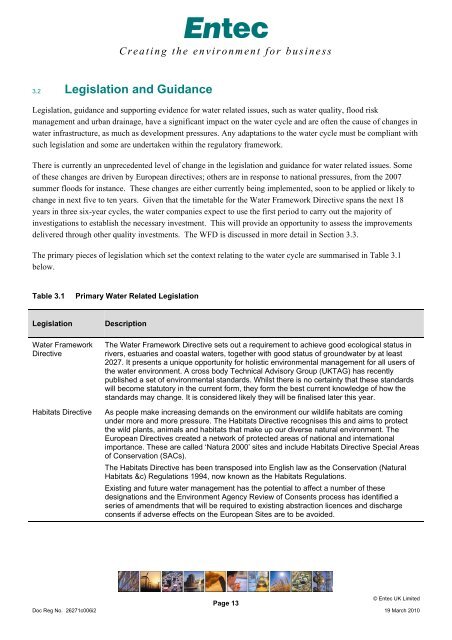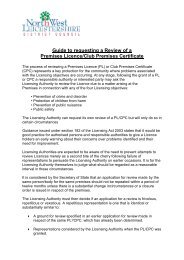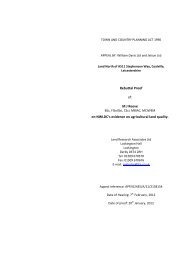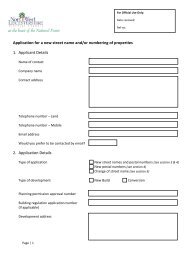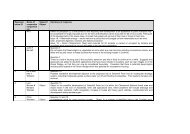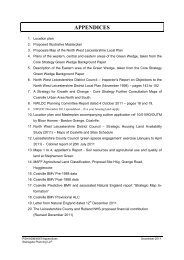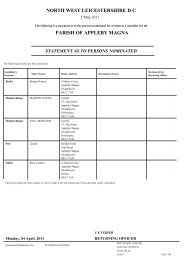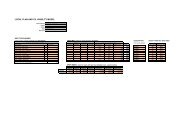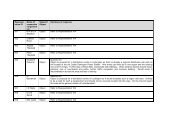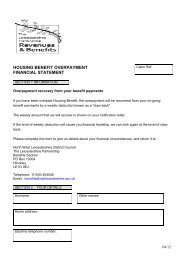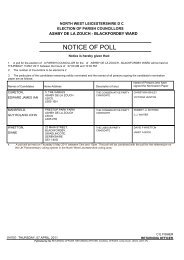Water Cycle Study - March 2010 - North West Leicestershire District ...
Water Cycle Study - March 2010 - North West Leicestershire District ...
Water Cycle Study - March 2010 - North West Leicestershire District ...
You also want an ePaper? Increase the reach of your titles
YUMPU automatically turns print PDFs into web optimized ePapers that Google loves.
Creating the environment for business<br />
3.2 Legislation and Guidance<br />
Legislation, guidance and supporting evidence for water related issues, such as water quality, flood risk<br />
management and urban drainage, have a significant impact on the water cycle and are often the cause of changes in<br />
water infrastructure, as much as development pressures. Any adaptations to the water cycle must be compliant with<br />
such legislation and some are undertaken within the regulatory framework.<br />
There is currently an unprecedented level of change in the legislation and guidance for water related issues. Some<br />
of these changes are driven by European directives; others are in response to national pressures, from the 2007<br />
summer floods for instance. These changes are either currently being implemented, soon to be applied or likely to<br />
change in next five to ten years. Given that the timetable for the <strong>Water</strong> Framework Directive spans the next 18<br />
years in three six-year cycles, the water companies expect to use the first period to carry out the majority of<br />
investigations to establish the necessary investment. This will provide an opportunity to assess the improvements<br />
delivered through other quality investments. The WFD is discussed in more detail in Section 3.3.<br />
The primary pieces of legislation which set the context relating to the water cycle are summarised in Table 3.1<br />
below.<br />
Table 3.1<br />
Primary <strong>Water</strong> Related Legislation<br />
Legislation<br />
Description<br />
<strong>Water</strong> Framework<br />
Directive<br />
Habitats Directive<br />
The <strong>Water</strong> Framework Directive sets out a requirement to achieve good ecological status in<br />
rivers, estuaries and coastal waters, together with good status of groundwater by at least<br />
2027. It presents a unique opportunity for holistic environmental management for all users of<br />
the water environment. A cross body Technical Advisory Group (UKTAG) has recently<br />
published a set of environmental standards. Whilst there is no certainty that these standards<br />
will become statutory in the current form, they form the best current knowledge of how the<br />
standards may change. It is considered likely they will be finalised later this year.<br />
As people make increasing demands on the environment our wildlife habitats are coming<br />
under more and more pressure. The Habitats Directive recognises this and aims to protect<br />
the wild plants, animals and habitats that make up our diverse natural environment. The<br />
European Directives created a network of protected areas of national and international<br />
importance. These are called ‘Natura 2000’ sites and include Habitats Directive Special Areas<br />
of Conservation (SACs).<br />
The Habitats Directive has been transposed into English law as the Conservation (Natural<br />
Habitats &c) Regulations 1994, now known as the Habitats Regulations.<br />
Existing and future water management has the potential to affect a number of these<br />
designations and the Environment Agency Review of Consents process has identified a<br />
series of amendments that will be required to existing abstraction licences and discharge<br />
consents if adverse effects on the European Sites are to be avoided.<br />
Doc Reg No. 26271c006i2<br />
Page 13<br />
© Entec UK Limited<br />
19 <strong>March</strong> <strong>2010</strong>


